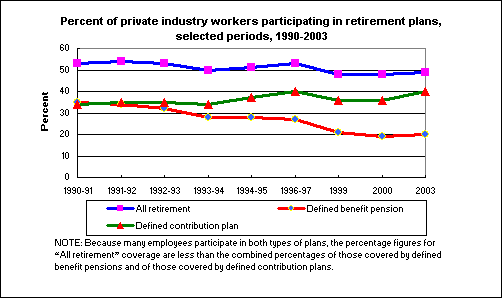| |
Printer-friendly version (HTML) |
Percent of Private Industry Workers Participating in Retirement Plans, Selected Periods, 1990-2003
by Jordan Pfuntner
Bureau of Labor Statistics
Originally Posted: July 28, 2004

- Retirement plans come in two forms: defined benefit pensions and defined contribution plans. A defined benefit pension is a retirement plan that uses a predetermined formula to calculate the amount of an employee’s future benefit. A defined contribution plan is a type of retirement plan in which the employer makes specified contributions to individual employee accounts, but the amount of the future retirement benefit is not specified.
- Over the last decade and a half, retirement plan coverage has held steady at about half of private industry workers,1 although the type of coverage has gradually shifted. At the beginning of the 1990s, defined benefit pensions and defined contribution plans each covered about one-third of private industry workers. By 2003, defined contribution plans covered about twice as many workers as did defined benefit pensions: 40 percent compared with 20 percent.
Jordan Pfuntner
Deputy Associate Commissioner, Office of Compensation and Working Conditions, Bureau of Labor Statistics.
Telephone: (202) 691-6309; E-mail: Pfuntner.Jordan@bls.gov
Note
1 BLS studied retirement plans for employees of State and local governments in the 1990s, conducting surveys in 1990, 1992, 1994, and 1998. Overall retirement plan coverage held relatively steady from 1990 to 1998, as did coverage by defined benefit pensions and defined contribution plans. During these years, 9 in 10 workers were covered by retirement plans; about 85 percent of workers had defined benefit pensions, and about 10 percent had defined contribution plans. (BLS last surveyed State and local governments for the prevalence of benefit plans in 1998.)
|